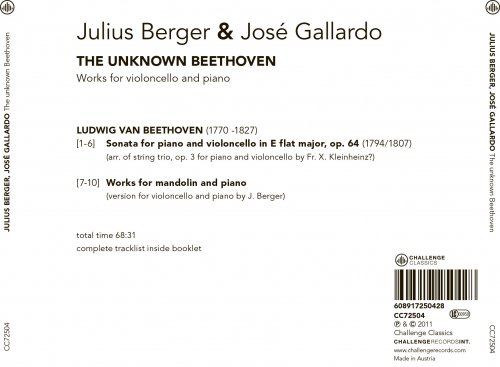
Julius Berger, José Gallardo - The Unknown Beetoven: Arrangements for violoncello & piano (2010)
BAND/ARTIST: Julius Berger, José Gallardo
- Title: The Unknown Beetoven: Arrangements for violoncello & piano
- Year Of Release: 2010
- Label: Challenge Classics
- Genre: Classical
- Quality: flac lossless (tracks) +Booklet
- Total Time: 01:08:30
- Total Size: 205 mb
- WebSite: Album Preview
Tracklist
01. Sonata for piano and violoncello in E flat major, op. 64: Allegro con brio
02. Sonata for piano and violoncello in E flat major, op. 64: Andante
03. Sonata for piano and violoncello in E flat major, op. 64: Menuetto: Allegretto
04. Sonata for piano and violoncello in E flat major, op. 64: Adagio
05. Sonata for piano and violoncello in E flat major, op. 64: Menuetto: Moderato
06. Sonata for piano and violoncello in E flat major, op. 64: Finale: Allegro
07. Works for mandolin and piano: Sonatine WoO 43a: Adagio
08. Works for mandolin and piano: Adagio ma non troppo WoO 43b
09. Works for mandolin and piano: Sonatine WoO 44a: Allegro
10. Works for mandolin and piano: Andante con variazioni WoO 44b

The "unknown Beethoven" designation in the graphics for this release is a stretch: the album contains an arrangement for which Beethoven had at most partial input, as well as four works for mandolin and piano (hardly well known, it must be admitted) arranged for cello and piano by the present performers. The major claims here are made for the Sonata for piano and cello in E flat major, Op. 64 (not "cello and piano," for the cello has a distinctly accompanimental role). This work is an arrangement of the six-movement String Trio in E flat major, Op. 3, a work heavily influenced by Mozart's Divertimento for string trio, K. 563, in the same key and written just a few years earlier. Since it was published with an opus number, a process over which Beethoven generally exerted at least some control, the arrangement was for a time taken to be Beethoven's own work, but then was removed from the canon and ascribed to one Fr. X. Kleinheinz. The only direct testimony comes from Beethoven's brother Caspar Carl, who wrote that the arrangement was made by Kleinheinz under Beethoven's "supervision," a word that can mean a lot of things. Cellist Julius Berger argues that the proximity of the publisher's offices to Beethoven's own home suggests his deeper involvement. The chief argument con, however is that the old-fashioned accompanied sonata model, which Beethoven never followed in any other work, doesn't match the material, which in 1794 was already stretching against the boundaries of Classical form, most notably in the big opening movement. The arrangement is cleanly played by Berger and pianist José Gallardo, and is pleasant enough, but it's marginal Beethoven at best. There are no complaints, however, about the little mandolin-to-cello pieces, arranged by Berger himself. These lie nicely on the cello, which is tuned similarly to a mandolin, and they resurrect some lovely examples of Beethoven's language in small pieces with which he took some care; they're of a piece with the Op. 33 set of Bagatelles, for example. The sustained lyricism of the Adagio ma non troppo, WoO 43b, and the final Andante con variazioni, WoO 44b, justifies the purchase for Beethoven enthusiasts who may be on the fence. Over-close sound from an Augsburg concert hall is a minus.
01. Sonata for piano and violoncello in E flat major, op. 64: Allegro con brio
02. Sonata for piano and violoncello in E flat major, op. 64: Andante
03. Sonata for piano and violoncello in E flat major, op. 64: Menuetto: Allegretto
04. Sonata for piano and violoncello in E flat major, op. 64: Adagio
05. Sonata for piano and violoncello in E flat major, op. 64: Menuetto: Moderato
06. Sonata for piano and violoncello in E flat major, op. 64: Finale: Allegro
07. Works for mandolin and piano: Sonatine WoO 43a: Adagio
08. Works for mandolin and piano: Adagio ma non troppo WoO 43b
09. Works for mandolin and piano: Sonatine WoO 44a: Allegro
10. Works for mandolin and piano: Andante con variazioni WoO 44b

The "unknown Beethoven" designation in the graphics for this release is a stretch: the album contains an arrangement for which Beethoven had at most partial input, as well as four works for mandolin and piano (hardly well known, it must be admitted) arranged for cello and piano by the present performers. The major claims here are made for the Sonata for piano and cello in E flat major, Op. 64 (not "cello and piano," for the cello has a distinctly accompanimental role). This work is an arrangement of the six-movement String Trio in E flat major, Op. 3, a work heavily influenced by Mozart's Divertimento for string trio, K. 563, in the same key and written just a few years earlier. Since it was published with an opus number, a process over which Beethoven generally exerted at least some control, the arrangement was for a time taken to be Beethoven's own work, but then was removed from the canon and ascribed to one Fr. X. Kleinheinz. The only direct testimony comes from Beethoven's brother Caspar Carl, who wrote that the arrangement was made by Kleinheinz under Beethoven's "supervision," a word that can mean a lot of things. Cellist Julius Berger argues that the proximity of the publisher's offices to Beethoven's own home suggests his deeper involvement. The chief argument con, however is that the old-fashioned accompanied sonata model, which Beethoven never followed in any other work, doesn't match the material, which in 1794 was already stretching against the boundaries of Classical form, most notably in the big opening movement. The arrangement is cleanly played by Berger and pianist José Gallardo, and is pleasant enough, but it's marginal Beethoven at best. There are no complaints, however, about the little mandolin-to-cello pieces, arranged by Berger himself. These lie nicely on the cello, which is tuned similarly to a mandolin, and they resurrect some lovely examples of Beethoven's language in small pieces with which he took some care; they're of a piece with the Op. 33 set of Bagatelles, for example. The sustained lyricism of the Adagio ma non troppo, WoO 43b, and the final Andante con variazioni, WoO 44b, justifies the purchase for Beethoven enthusiasts who may be on the fence. Over-close sound from an Augsburg concert hall is a minus.
As a ISRA.CLOUD's PREMIUM member you will have the following benefits:
- Unlimited high speed downloads
- Download directly without waiting time
- Unlimited parallel downloads
- Support for download accelerators
- No advertising
- Resume broken downloads


